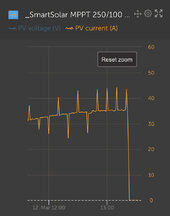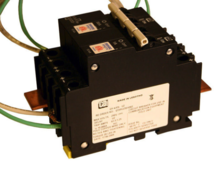ricardocello
Watching and Learning
Well, best solar day of the year so far.
Unfortunately, I found out that I was too conservative designing the main PV breaker at 40A (4s3p configuration).
It tripped today. Guess I’ll bump it to 50A. Cable size is adequate, no issue there.
Good news: The inexpensive amazon Langir DC breaker actually worked!
Bad news: The Victron MPPT during its scans really spikes the current.
Good news: Wife knows where all the disconnects are now.

Unfortunately, I found out that I was too conservative designing the main PV breaker at 40A (4s3p configuration).
It tripped today. Guess I’ll bump it to 50A. Cable size is adequate, no issue there.
Good news: The inexpensive amazon Langir DC breaker actually worked!
Bad news: The Victron MPPT during its scans really spikes the current.
Good news: Wife knows where all the disconnects are now.





